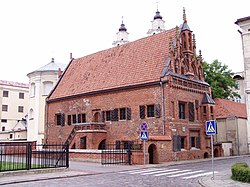This article needs additional citations for verification .(July 2021) |
Lithuania is not the very centre of Gothic architecture, but it provides a number of examples, partly very different and some quite unique.
Contents

This article needs additional citations for verification .(July 2021) |
Lithuania is not the very centre of Gothic architecture, but it provides a number of examples, partly very different and some quite unique.


Lithuania, situated at the border of Greek [1] and Roman Church had developed by the defence of its paganism, especially against the Teutonic Order to become a state and in the 14th century a major power.[ citation needed ] The territory of nowaday's republic, except Lithuania Minor, which was ruled by the Teutonic Order, was the Lithuanian speaking part of the Grand Duchy of Lithuania, with its Slavic and Orthodox majority of subjects. The centre of power of this large state lay among Kaunas, Trakai and Vilnius.
The marriage of Grand Duke Jogaila and the Queen of Poland Jadwiga began the personal union of Lithuania and Poland. After the Battle of Grunwald in 1410 and by the Treaty of Melno in 1422 the attacks of the Teutonic Order ceased. After the Second Peace of Thorn, the Order was not any more a serious competitor in the region.

Castles built of stones and bricks, dates of the first complete building after wooden precursors:
Almost all Lithuanian medieval castles and fortifications were built of wood and earth.

The oldest church in Lithuania, built from bricks, is the Orthodox Cathedral of the Theotokos, Vilnius. It was constructed in 1346, when the Renaissance style had not yet arrived in central Europe, and in the Grand Duchy only the Slavic population was Christian.[ citation needed ] The roofs and design of the outer walls underwent some changes during the course of centuries. Today, the outer appearance is Neo-Byzantine, and most of the walls are plastered. [3]

After Jogaila had been baptized a Catholic, the country officially became Catholic, and churches were built also for the Grand Duchy's Lithuanian population. Soon the most important churches were erected in Brick Gothic:

In the late Gothic period, two exceptional buildings were built in Lithuania, following the abundant French Flamboyant style, but realized in bricks.